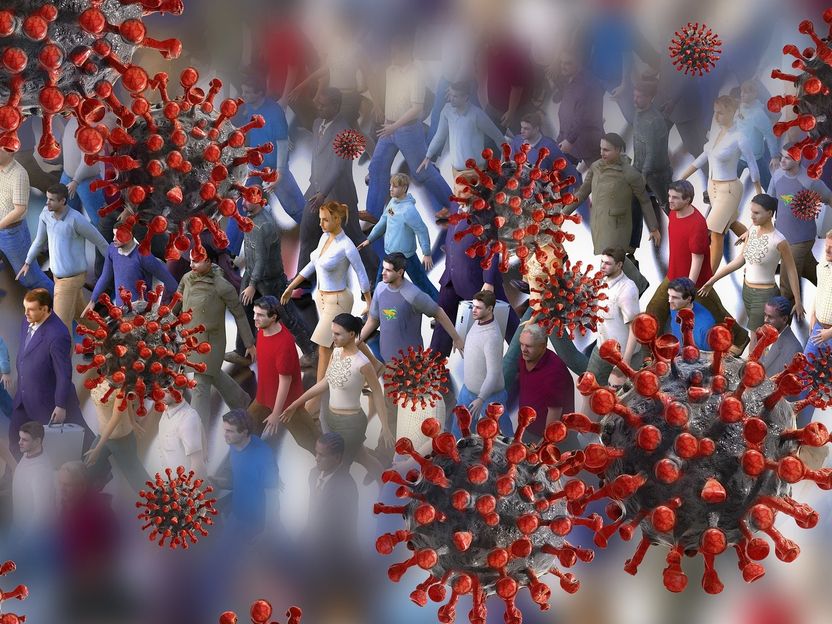COVID-19 has multiple faces
Scientists present latest findings on the coronavirus
According to current studies, the Covid-19 disease which is caused by the SARS-CoV-2 coronavirus comprises at least five different variants. These differ in how the immune system responds to the infection. Researchers from the German Center for Neurodegenerative Diseases (DZNE) and the University of Bonn, together with other experts from Germany, Greece and the Netherlands, present these findings in the scientific journal “Genome Medicine”. Their results may help to improve the treatment of the disease.

Symbolic image
geralt, pixabay.com
Infection with SARS-CoV-2 can manifest in different ways: Many of those affected do not even seem to notice the presence of the virus in their bodies. In other cases, the effects can include flu-like symptoms and neurological disorders to severe and even life-threatening pneumonia. “The classification of COVID-19 into mild and severe courses falls short. The disease is much more diverse, and for each affected person, one certainly would want a therapy that is tailored to fit. What helps one person may be ineffective for another,” said Dr. Anna Aschenbrenner, a scientist of the LIMES Institute at the University of Bonn and the DZNE’s Systems Medicine division. “In this respect, it is obvious to want to understand what underlies these differences. If we can pin them down to scientific criteria and categorize patients accordingly, this increases the chances of effective treatment. We therefore took a look at the immune system. Because many studies are indicating that its response to infection with SARS-CoV-2 plays a crucial role in the course of COVID-19,” said Aschenbrenner, who is a member of the “ImmunoSensation2” Cluster of Excellence at the University of Bonn.
International Cooperation
In light of this, a team led by Anna Aschenbrenner, along with colleagues in Germany and abroad, analyzed the blood of people with and without COVID-19. The samples came from a total of 95 people distributed among Bonn, Athens and Nijmegen. The research was done in collaboration with the “German COVID-19 OMICS Initiative” (DeCOI) - a network of German universities and research institutions. In Bonn, the DZNE and the University of Bonn were involved, as well as the University Hospital. Partners abroad were the Attikon University Hospital as well as the Sotiria Hospital in Athens, Greece, and the Radboud University Medical Center in Nijmegen in the Netherlands.
For each patient, the so-called transcriptome of the immune cells in the blood was determined. This requires the analysis of large amounts of data using bioinformatics methods. Based on the molecular fingerprint generated in this way, the researchers were able to identify which genes within the immune cells were switched on or off. Such signatures of gene activity – known as “expression patterns” - provide information about the condition of cells and thus about their properties and functions, which can change depending on the situation.
Interestingly, the picture obtained in this way was largely determined by the family of “neutrophils”, which are the most abundant of the so-called white blood cells and quite up front in the reaction chain of the immune response. These cells are thus mobilized very early to defend against infections. They act upon the formation of antibodies and, moreover, on other cells that contribute to immunity.
Five Manifestations
“First of all, it is important to note that the expression patterns of immune cells in people with COVID-19 differ fundamentally from those in healthy individuals. The gene activity we can detect in the blood is strongly altered. But there are also striking differences among patients. On this basis, we have identified five different groups. We refer to them as molecular phenotypes,” said Dr. Thomas Ulas, an expert in bioinformatics at the DZNE. “Two of them represent severe disease courses. The others have more moderate symptoms.” The classification was based solely on transcriptome data. Only in retrospect, molecular phenotypes were matched to registered clinical courses.
COVID-19 Is Different
The researchers used their findings to compare COVID-19 with other diseases and also with data from healthy individuals. For this purpose, they were able to draw on data from the “Rhineland Study” - a population study conducted by the DZNE in the Bonn area - as well as on data from scientific databases. For the comparison, a large spectrum of diseases was considered: including viral infections such as influenza, infections with HIV and Zika, bacterial infections such as tuberculosis and bacterial sepsis, and inflammatory diseases such as rheumatoid arthritis. “All five COVID-19 phenotypes are different from the other diseases we studied,” Ulas said, summing up the findings. “Apparently, COVID-19 has a unique biology that is reflected in the gene activity of immune cells in the blood. Insofar, expression analysis could be used to diagnose COVID-19. This would be an alternative or complement to current methods.”
Searching for Drugs
The scientists also searched for potential drugs against COVID-19. For this, they drew on the effects registered in databases of around 900 approved drugs on the expression patterns of cells. “We calculated which pharmaceuticals could counteract the altered gene activity profiles of the individual COVID-19 phenotypes,” said Aschenbrenner. On this basis, drug candidates for therapy were identified. “Already in April of last year, we calculated a potential efficacy for example for dexamethasone and baricitinib in one of the patient groups with severe course that we identified. These types of analyses, it must be clearly stated, are not treatment recommendations. They do, however, very much provide starting points for therapy development, which then need to be tested in appropriate trials. In the case of dexamethasone and baricitinib, our predictions turned out to be correct. This is an indication of the strength of our approach of using blood transcriptomes to better characterize and classify patients.”




















































